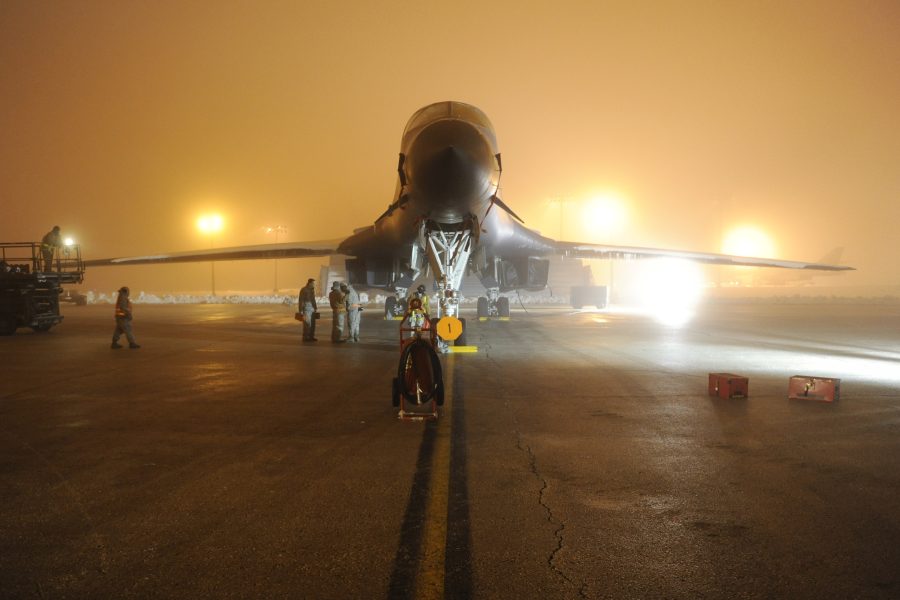B-1B Lancer flight operations from Ellsworth Air Force Base, S.D., are still paused following a Jan. 4 crash of a bomber at the base, and the base’s runway remains closed, the Air Force said.
The scene has not been cleared and the runway is expected to remain closed past Jan. 19, as crash evidence continues to be processed and investigated, a service official told Air & Space Forces Magazine.
“The Ellsworth AFB runway will remain closed while investigators continue to look into the cause of the B-1B crash Jan. 4, 2024,” Col. Derek Oakley, 28th Bomb Wing commander, added in an emailed statement. “We continue to thank the community for their outpouring of support and well wishes for the aircrew and say ‘thank you’ to all those who continue to work the scene and the investigation.”
Imagery circulating online shows that the aircraft is severely burned and suffered significant damage after crashing and skidding off the runway. The official said the aircraft was likely not in a “fixable situation,” nor was it airworthy.
Ellsworth’s sole runway has been closed since the crash, according to a Notice to Airmen/Notice to Air Missions (NOTAM). The latest notice was set to expire on Jan. 19. B-1 operations from Dyess Air Force Base, Texas—the only other combat B-1 base—continue. The Air Force also maintains some B-1s for test operations.
“Losing an aircraft is difficult, but I cannot emphasize enough we have four safe aircrew,” Oakley said on Jan. 9 in a video statement.
The crashed B-1 has not yet been deemed a total loss or officially declared a Class A mishap. A Class A mishap is any accident that involves loss of life, severe injury, loss of an aircraft, or other damage totaling more than $2.5 million.
All four aircrew ejected safely. Three were treated on base after the accident and released; one Airman required hospitalization. No one else was injured, the base said.
“Flying operations were paused on Jan. 4 to ensure the safety of our Airmen and our airfield,” Oakley said on Jan. 9. “We are carefully assessing checklists and safety procedures to resume flying when safe to do so.”
Weather conditions at the time of the accident were poor, with limited visibility due to dense fog and below-freezing temperatures. Two B-1s assigned to Ellsworth were conducting a local training mission when they came into land on the evening of Jan. 4. The lead aircraft landed without incident, but the second B-1 in the two-ship formation crashed at approximately 5:50 p.m. local time, base officials said.
Oakley said Jan. 9 that an Air Force investigation team was on site as part of a “thorough investigation process” and that evidence from the incident was being preserved. He added that an accident investigation board was expected to begin work and then prepare a publicly releasable report. In that case, the site must be fully documented, with what remains of the B-1 taken for further examination as needed.
An accident investigation board is an intensive, months-long process. Such an investigation probes crew actions, health, rest, and training; the aircraft’s maintenance history; weather conditions; and other factors. A recent investigation into a mishap involving an F-35 found a maintainer left a flashlight in the engine intake, causing nearly $4 million worth of damage. While the report faulted the individual Airman, it also cited a number of contributing factors.
The Air Force has 45 B-1s in its inventory—44 of which are flightworthy following the crash at Ellsworth. The B-1, originally envisioned as a supersonic, nuclear-capable bomber, had to meet extensive demands for airpower over Iraq and Afghanistan over the past two decades after being converted to a purely conventional bomber, leaving the fleet with poor mission-capable rates. The Air Force retired 17 B-1s in recent years to improve reliability, with more spare parts and maintenance crews available to work on a smaller fleet.
